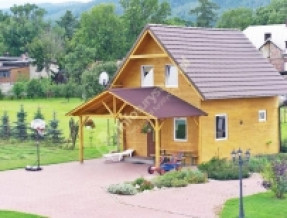Domki Miłków
Liczba ofert: 3

Dom Wczasowy CHATKA KARKONOSKA
(0 opinii)
Każdy z domków dysponuje aneksem z doskonale+ wyposażoną kuchnią. Do dyspozycji gości na parterze wygodny, przestronny salonik, łazienka. Przed domkiem dużo terenu zielonego, plac-

Od 350 zł
(0 opinii)
Domek pod Śnieżką
Serdecznie zapraszamy Państwa do naszego obiektu Domek+ pod Śnieżką!-

Od 47 zł
(3 opinii)
Domek Miłe Zacisze
Planujesz urlop lub kilku dniowy wyjazd w+ gronie najbliższych? Zatrzymaj się u nas!Domek Miłe Zacisze to nowo wybudowany obiekt, znajdujący się zaledwie 3 km-
O miejscowości Miłków
Noclegi w mieście
Noclegi na wsi
Noclegi w lesie
Noclegi nad morzem
Noclegi nad jeziorem
Noclegi w górach
Sudety i przedg. sudeckie noclegi
Góry Świętokrzyskie noclegi
Podhale noclegi
Mazury noclegi
Jura Krakowsko-Częstochowska noclegi
Bieszczady noclegi
Bory Tucholskie noclegi
Pieniny noclegi
Beskid Żywiecki noclegi
Gorce noclegi
Beskid Śląski noclegi
Ponidzie noclegi
Karkonosze noclegi
Ziemia Łódzka noclegi
Ziemia Lubuska noclegi
Beskid Sądecki noclegi
Beskid Wyspowy noclegi
Kaszuby noclegi
Kujawy noclegi
Lubelszczyzna noclegi
Mazowsze noclegi
Mierzeja Wiślana noclegi
Podlasie noclegi
Pomorze Wschodnie noclegi
Pomorze Zachodnie noclegi
Roztocze noclegi
Sudety - Masyw Śnieżnik noclegi
Suwalszczyzna noclegi
Śląsk noclegi
Dolny Śląsk noclegi
Warmia noclegi
Wielkopolska noclegi
Trójmiasto noclegi
Inny noclegi
Wyżyna Sandomierska noclegi
Góry Stołowe noclegi
Wyżyna Lubelska noclegi
Orawa noclegi
Opolszczyzna noclegi
Beskid Orawsko-Podhalański noclegi
Beskid Niski noclegi
Pogórze Przemyskie noclegi
Beskid Mały noclegi
Beskid Makowski noclegi
Pogórze Karpackie noclegi
Góry Izerskie noclegi
Góry Bystrzyckie noclegi
Kotlina Kłodzka noclegi
Pojezierze Pomorskie noclegi
Zakopane noclegi
Karpacz noclegi
Solina noclegi
Szczawnica noclegi
Szklarska Poręba noclegi
Polańczyk noclegi
Kołobrzeg noclegi
Ustrzyki Dolne noclegi
Krynica-Zdrój noclegi
Święta Katarzyna noclegi
Roztocze noclegi
Sandomierz noclegi
Kielce noclegi
Kluszkowce noclegi
Bałtów noclegi
Zwierzyniec noclegi
Mikołajki noclegi
Giżycko noclegi
Białka Tatrzańska noclegi
Bukowina Tatrzańska noclegi
Kościelisko noclegi
Czorsztyn noclegi
Niedzica noclegi
Polanica-Zdrój noclegi
Kudowa-Zdrój noclegi
Warszawa noclegi
Kraków noclegi
Wrocław noclegi
Karkonosze noclegi
Ruciane Nida noclegi
Węgorzewo noclegi
Olsztyn noclegi
Mrągowo noclegi
Ełk noclegi
Augustów noclegi
Mielno noclegi
Ustroń noclegi
Władysławowo noclegi
Sopot noclegi
Gdynia noclegi
Gdańsk noclegi
Wisła noclegi
Szczyrk noclegi
Kazimierz Dolny noclegi
Zamość noclegi
Sromowce Niżne noclegi
Krynica Morska noclegi
Ustka noclegi
Łeba noclegi
Darłowo noclegi
Jastrzębia Góra noclegi
Hel noclegi
Jastarnia noclegi
Dąbki noclegi
Zakopane noclegi centrum
Koniaków noclegi
Istebna noclegi
Lublin noclegi
Biały Dunajec
Szaflary noclegi
Murzasichle noclegi
Chochołów noclegi
Witów noclegi
Muszyna noclegi
Cisna noclegi
Wetlina noclegi
Smerek noclegi
Krasnobród noclegi
Białowieża noclegi
Hajnówka noclegi
Morąg noclegi
Orzysz noclegi
Ryn noclegi
Pisz noclegi
Jarosławiec noclegi
Rowy noclegi
Ustronie Morskie noclegi
Międzyzdroje noclegi
Świnoujście noclegi
Kłodzko noclegi
Świeradów-Zdrój noclegi
Duszniki-Zdrój noclegi
Beskidy noclegi dla rodzin z dziećmi
Beskidy noclegi apartamenty
Beskidy noclegi
Beskidy noclegi z wyżywieniem
Beskidy weekend - noclegi
Beskidy noclegi dla grup zorganizowanych
Beskidy domki 4 osobowe
Beskidy noclegi blisko szlaków turystycznych
Beskidy noclegi z sauną
Beskidy noclegi z jacuzzi
Beskidy noclegi z basenem
Beskidy noclegi domki
Beskidy noclegi z psem
Beskidy tanie noclegi
Beskidy domki z jacuzzi
Beskidy Boże Narodzenie - noclegi
Beskidy domki 6 osobowe
Beskidy noclegi z widokiem na góry
Beskidy majówka - noclegi
Beskidy domki 8, 10, 12 osobowe
Beskidy noclegi ze śniadaniem
Beskidy wakacje - noclegi
Beskidy ferie zimowe - noclegi


